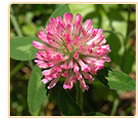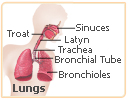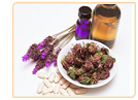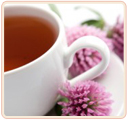Uses of Red Clover
 Red clover has many medicinal properties and is used to treat a variety of conditions ranging from skin disorders to the menopausal symptoms affecting middle-aged women. Red clover has many medicinal properties and is used to treat a variety of conditions ranging from skin disorders to the menopausal symptoms affecting middle-aged women.
Red clovers� widespread use is down to the healing potential of its organic properties. In addition to its phytoestrogenic properties, red clover contains high levels of minerals and vitamins, and is used to strengthen the body's immune system.
Such medicinal properties mean that red clover was commonly used by ancient cultures to cure a variety of ailments. Its historical uses are explained in more detail below.
The Uses of Red Clover Throughout History
Red clover originated from central Europe, but due to the simple conditions in which it grows, it has gone on to thrive in most corners of the world. For this reason, it has been used by many cultures and peoples throughout history in a variety of ways. Some of these are listed below:
 Respiratory problems: Chinese physicians and Russian folk healers used red clover to treat such problems and it is useful because it can clear phlegm from the throat. Respiratory problems: Chinese physicians and Russian folk healers used red clover to treat such problems and it is useful because it can clear phlegm from the throat.
A blood thinner: Ancient cultures believed the root of most malefactions? was the increase in toxins in the blood. Red clover was thought to purify the blood in reaction to conditions such as cancer, eczema, and venereal diseases.
The ancient uses of red clover are not dissimilar to its modern day uses. Some of these are discussed below.
Modern Day Uses of Red Clover
 Blood thinner: Red clover can help fight against blood clots and high cholesterol, which reduces the risk of a stroke. Blood thinner: Red clover can help fight against blood clots and high cholesterol, which reduces the risk of a stroke.
Menopause: The isoflavones in red clover mimic estrogen and balance the body's estrogen levels , which eases menopause symptoms such as hot flashes and night sweats.
Red clover has also been found to strengthen the arteries and improve the flexibility of their walls in pre and post-menopausal women. Furthermore, it helps to slow the bone density mineral loss that takes place during menopause.
Skin conditions: Red clover can be applied to the skin to help people suffering from eczema.
Bites and stings: For the less serious afflictions of insect bites or stings, a freshly crushed flower applied directly to the wound is all that is needed.
Infections: Chinese scientists have also proved that red clover kills viral and fungal infections. Able to rid the body of toxins, red clover purifies the liver by acting as a diuretic and also purifies the lungs by acting as an expectorant, so the body can get rid of mucus.
Different Forms of Red Clover
The red clover plant acts as a blood thinner when eaten in its uncooked form and this helps improve blood circulation. The herb also has healing properties that allow it to be applied directly onto the body to treat certain skin conditions, such as psoriasis and eczema.
Red clover can be used in a variety of ways:
 . Red clover extract is used in pills, tinctures, and supplement tablets. . Red clover extract is used in pills, tinctures, and supplement tablets.
. Its leaves can be boiled for tea.
. The plant can also be made into syrup.
Dosage of Red Clover
For prescriptions of red clover, a standardized measure of 40mg is normally used per tablet or capsule. This is the common isoflavone content in popular products such as Promensil. For menopause treatment, the recommended dosage of isoflavones is 80 mg in the form of two 40mg pills.
For other conditions dosages vary, but the following are recommended:
For skin conditions: For ailments such as eczema a liquid extract, ointment or infusion containing 10-15% should be used. Discontinue use if irritation occurs. This dosage should never be applied to an open wound unless advised by a doctor. For consumption in tea the following forms and dosages are suggested:
 Fluid Extract: 1 ml three times a day to be added to hot water to form tea. Fluid Extract: 1 ml three times a day to be added to hot water to form tea.
Dried Herb: 1-2 tsp. of dried flowers or flowering tops that must be placed into approximately 8 oz. of hot water for 30 minutes. Two-three cups should be drunk daily.
Tincture (30% alcohol): 60-100 drops (3-5ml) should be added to hot water to create tea.
Red Clover Overdose
There hasn�t been a great deal of research into the exact dangers of a red clover overdose. However an overdose has been known to cause unusual bruising or bleeding due to red clover�s ability to thin the blood.
Because red clover contains estrogen-like compounds, an overdose could lead to medical complications for women, including a disruption in the menstrual cycle and vaginal bleeding or spotting.
Now that the uses of red clover have been covered, continue reading to learn more about red clover benefits.
Conclusions about Red Clover
Red clover is great for treating some menopause symptoms, but as a phytoestrogenic herb it can cause a number of harmful side effects. Also, red clover has been criticized because it can interfere with the treatment of breast cancer.
Other alternative treatments are just as effective as red clover, but without the side effects. Non-estrogenic herbs, for example, are a great option for treating menopause symptoms. Read more in the following article.
Which herb should women try? Today women are looking for relief from their menopause symptoms with herbs. Phytoestrogenic herbs and non-estrogenic herbs are good in relieving menopause symptoms, but recent studies show that non-estrogenic herbs have no side effects because they help the body to produce its own hormones instead of introducing hormones like the phytoestrogenic ones. Learn more about non-estrogenic herbs for menopause.
| 

